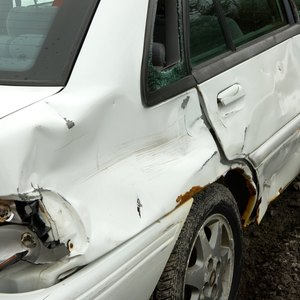
Car accidents can happen to anyone. If the damage to your car is serious enough, you could find yourself in a very stressful situation -- especially if you still owe on the car. If your insurer declares the vehicle a total loss, they’ll still cut you a check, but only for the car’s current market value. There could be a significant difference between the insurance proceeds and the amount you still owe the lender. That’s what a guaranteed auto protection, or GAP, policy guards against. If you total your car and your regular insurance doesn’t pay off what you owe, your GAP policy kicks in and pays the difference.
Short Answer
Most states require auto insurance, but it’s usually what’s called public liability and property damage, or PLPD. It protects you from financial losses related to damage your car causes to others or their property. GAP insurance, however, is not required by law. In fact, some states -- Alabama, Louisiana and New York, for example -- don’t even offer it. That doesn’t mean it can’t be required as a condition of your financing, however. Some leases require it and may actually bundle it into your lease. Even if your lender doesn’t make you buy it, though, GAP insurance can still be a smart purchase.
GAP Insurance Can Protect Your Credit
Lenders generally require you to carry full-coverage insurance on your car as long as you owe on it. But if it’s totaled and the insurance doesn’t give you enough to pay it off, your lender still expects to be repaid. If you don’t make good on your agreement, your credit score will suffer. Failure to pay off a totaled automobile is a common source of credit problems that can haunt you for years. A GAP policy is an especially good idea for younger consumers -- damaged credit can take years to rebuild.
Snowball Effect
If you owed $10,000 on your wrecked car, for example, but your insurance company only gave you $7,500 for it, then you still owe a balance of $2,500. That’s called negative equity, and chances are you don’t have that kind of cash just lying around. Your only recourse, then, is to roll that negative equity into the purchase of your next car. That puts you at a disadvantage during the term of your loan. It’s unlikely you’ll be able to trade it in on another car until it’s completely paid off because you’ll almost certainly always owe more than it’s worth. If you had purchased GAP insurance on that first vehicle, you could have started with a clean slate after the accident.
Sources, Pricing and Alternatives
In states that allow GAP coverage, car dealers are one way to get it. Despite the convenience, however, going that route might not be the best option. Dealers typically roll the cost of the insurance into your contract, which means you’re paying interest on it, and your cancellation options could be limited. You may be able to secure the same protection more cheaply by going through your auto insurance agent, and some banks offer it as well. A GAP policy generally costs only a few hundred dollars for the entire term of your loan. In some states, including those that don’t offer GAP insurance, you can purchase a “total loss” policy, which will pay out enough to clear the debt on your car, or give you enough to replace it. Putting down a significant amount toward an auto lease or purchase can reduce the risks that GAP insurance is designed to avoid.
References
Writer Bio
Christopher Williams has owned and operated his own small business since 2002, and has a wide range of professional experience in retail, sales and insurance industries. He's been writing professionally since 2004.

